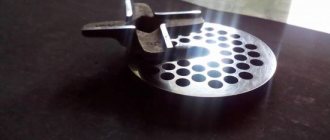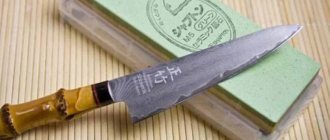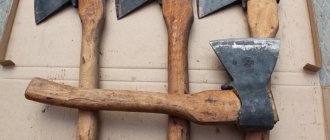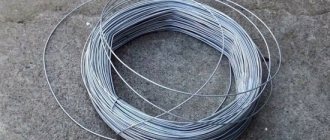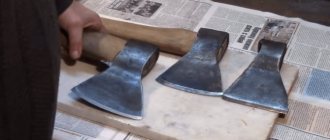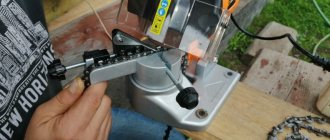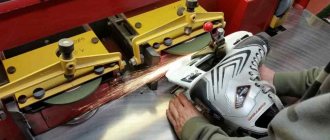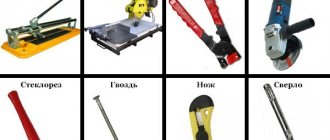Today, the population prefers life in the city, and suburban areas, as a rule, are purchased for recreation. Often, on the territory of such country houses, people build bathhouses or install stove heating in the house. This is where the issue of firewood procurement becomes relevant. In the modern world, this is not a very popular activity.
A huge number of different devices have been created that help chop firewood, both with and without human participation. Lighting a fireplace or sauna may still require manual labor, and you will have to chop the wood yourself using a wood splitter. How to choose the right cleaver for firewood, what to look for when purchasing? What is the difference between an ax and a cleaver and how to choose the right and correct tool suitable for a particular person? Today we will look for answers to these questions.
Many people mistakenly believe that an ax is the same as a cleaver. In fact, these are different things. More precisely, a firewood cleaver is a type of axe. Its main difference is that trees are cut down with an ax, and firewood is chopped with a cleaver . Thanks to it, even a huge tree trunk turns into small logs, which are very convenient to use.
In addition to functionality, it differs from an ax in appearance. The ax has a thin, very sharp blade with slight curves. The cleaver is a rather voluminous structure, the weight of which can be three kilograms, and the ax handle is quite long.
When talking about a cleaver or an axe, there is no need to explain the method of their use, since it is clear to everyone. When cutting down a tree, you need to repeatedly hit the trunk with an ax, while holding the tool at arm's length. Working with a cleaver is a little different: the log should split into pieces with one blow. It is not difficult to understand that the sharpness of its blade is important for an ax, and the striking force for a cleaver .
Structure and types of tools
There is nothing to say about the design of this tool - it consists of an ax and a “head”. Everything is very simple and clear.
As a rule, the ax handle is made of flexible and soft wood, which includes:
Some craftsmen make axes from oak, but such an ax or cleaver can only be used by an experienced woodcutter. Oak is a fairly hard wood and this is a significant disadvantage for an instrument. The handle will break very quickly due to the fact that there will be no vibration damping upon impact, and it will simply crack. This, unfortunately, happens quite often.
Externally, the tool is very similar to a sledgehammer with a sharpened side (blade), the other side is called the butt. The weight of such a “head” can be from three to five kilograms. The blade must be sharpened at an angle of 45 degrees, this is what causes the log to split into pieces.
The ax has many varieties:
- universal;
- blacksmith;
- for the lumberjack;
- carpentry;
- butcher;
- firefighter.
Cleavers are divided into only two types:
The first type is very similar to a sledgehammer, and the second is the same in weight, but the blade is sharper.
There is another classification of cleavers, according to which the tool can be:
There is no significant difference when using the tool; these factors do not have much influence on the quality of the result. The structure of the cleaver is much more important.
There are no universal recommendations for choosing a cleaver for chopping wood. You should choose a tool based on some individual factors:
- weight;
- ax material;
- length of the ax;
- blade shape.
The weight of the tool is the most ambiguous characteristic. On the one hand, a heavier cleaver will be easier to chop wood; when working with a lighter one, you will need to hit the wood several times.
It should be borne in mind that collecting firewood is not an easy and long process. Not every man can swing a cleaver for several hours in a row. That is why a tool for chopping wood must correspond to the physical capabilities of the particular person who will work with it.
Unfortunately, you may not find your ideal tool right away. If you are buying a tool for yourself, then you should not take the first one you come across. You need to hold the model in your hands, swing it and feel its work.
For a person with average physical fitness, the optimal weight of the instrument will be 2-2.5 kilograms. For larger and stronger people, a heavier cleaver is quite suitable. It is very convenient to work with a light tool; it splits small logs without any problems, but it may not be able to cope with larger logs.
Blade shape
A suitable cleaver can be selected according to the shape of the blade. They come in two versions:
The eared species appeared on the market relatively recently and reviews about it are contradictory. Experienced woodcutters say that it often does not split logs and gets stuck very firmly in them.
This suggests the conclusion that the wedge-shaped species has no competition, but in fact this is not the case. The instructions for the “eared” blade contain a disclaimer stating that only dry firewood can be split with this tool . It's no secret that very often people chop raw or freshly cut firewood, for which the wedge-shaped type is best suited. The main thing is to use the tool correctly and then everything will definitely work out!
Until recently, cleavers only had wooden handles. The handles of axes and cleavers have always been made of wood to dampen the vibrations of the blows. It is impossible not to say about the cost of such axes, since their low cost is a fundamental factor in purchases for many people.
There is only one drawback to such handles, and that is that they can crack if used improperly. The point is not in the strength of the handle, and not in its quality, but in the striking technique.
More recently, handles made from a composite material called fiberglass began to be produced. Despite the fact that it is very light, fiberglass is superior to wood in many ways, especially in its strength. Vibration damping from impact in this material is also at the proper level. This handle makes the tool very comfortable , dense and durable. A handle made of composite material can be of any length, and therefore this option is preferable to a model with a wooden ax.
The length of the handle directly affects the force of the blow - the longer the lever, the greater the force. To fully unlock the potential of such a cleaver, you need to use it correctly. In other words, using a long handle will only be effective in the hands of an experienced person. Beginner users will find it difficult to work with such a tool.
Choosing a cleaver
- First of all, you need to take into account the weight of the tool, since it must correspond to the physical development of the person who will use it.
- Before purchasing a tool, you need to consider what type of firewood will be split: dry or wet. In accordance with this, you need to buy either the “eared” or wedge-shaped type.
- The length of the ax and the material from which it is made are very important. Here user experience is a fundamental factor. You should also consider your financial capabilities. The wooden handle is not very practical, but its cost is very affordable. A handle made of composite material is much more practical, but much more expensive.
Terms of use
Even with the best model of a cleaver, an inexperienced person will not be able to work effectively. When chopping wood for the first time using a cleaver, we recommend using some tips that will make your work much easier.
First, you need to choose the widest deck and place it evenly on the ground. Chocks will be installed on it, like on a block. In addition to organizing the workplace, you need to pay attention to the logs themselves, since wet logs will split much harder , while dry ones will split in no time.
The split firewood must match the size of the firebox in which it will be used. Their length should be no more than three quarters of the oven space, and their diameter should not be more than 10 centimeters. Such firewood will burn for a long time and save fuel.
The number of parts from one chock completely depends on the size of the chock itself. From small logs you get 2-4 pieces, from large ones - about eight. When working with large logs, do not try to split them in half in one motion. It will be much easier to trim them around the edges and cut the rest in half. At first, this process seems very simple, although it is quite possible to improve this matter and spend less energy.
Before harvesting, be sure to dry the firewood or at least dry it a little. In winter, the logs should be allowed to freeze , then the wood will not be loose and will easily split. If there is a crack on the chock, then you need to try to get into it. If this fails, then you need to insert a blade into it and hit the butt with a sledgehammer. If you don’t have a sledgehammer, then you need to take a deck with a cleaver, swing it hard, turn it over in the air, and hit the block with the butt. These are radical measures in which the lump will definitely split.
If there are knots in the deck, then you need to hit between them. If there is a problem similar to the situation with a crack, then you need to do the same. Chopping wood with your own hands is not that difficult. The main thing is not to rush and quit at the first failure. You need to try again - and with experience this activity will bring pleasure.
Precautionary measures
When preparing firewood, it is imperative to observe safety measures, regardless of how this work will be carried out: with a cleaver or an electric or mechanical wood splitter.
You must always be on guard, as during the work, chips fly in different directions, the trajectory of which is unpredictable. Therefore, the area for chopping wood must be suitable, that is, at a distance from people and animals.
A cleaver (like an ax) is a dangerous tool, and one wrong move can result in injury. The correctly selected tool and the rules for its use significantly affect human safety.
Particular attention should be paid to the deck on which the firewood will be split, as well as to the lump that will split. It should not be larger in diameter than the block, and its height should be slightly above the knee. If you install the block incorrectly, it will be quite problematic to deliver the right and strong blow that will split it.
Before starting work, you need to think about your protection and wear goggles and gloves. Safety glasses will help prevent splinters and wood dust from getting into your eyes, and gloves will give you a better grip on the handle. If you follow all safety rules, this activity will become easy and even fun. Firewood will split easily and correctly.
How to sharpen an ax correctly
When sharpening an ax with your own hands at home, consider:
- level of wood hardness, which depends on the type of wood;
- humidity indicator;
- types of jobs;
- the type of steel from which the working part was made.
The master is recommended to use the double release method. In this case, initially an angle of 15° is achieved on the working part. During further processing of the cutting edge, an angle of at least 25° is made. This sharpening allows you to obtain a tool for precision carpentry work, as well as cutting small branches and firewood. The cleaver is edited as it becomes dull with a simple file with a fine notch.
Common mistakes
As a result of editing the metal part of the ax, some errors may occur, for example:
- When working on an electrically driven grinding machine, the metal sometimes overheats. This phenomenon leads to a decrease in the strength characteristics of the material. To avoid heating, it is necessary to moisten the sanding wheel with water during processing.
- If you do not secure the grinder, the wheel may break. Thus, the angle is not maintained. The blade will be damaged; the thickness will not be the same everywhere.
- Using an uneven abrasive wheel will damage the blade and sometimes cause the sandpaper to break during use.
The operation of processing the working edge of a tool is dangerous. It is necessary to observe safety measures and use personal protective equipment.
How to choose a cleaver
The log should be installed on the far side of the block, then the cleaver, if hit incorrectly, will stick into the block itself, and not into the knee of the person chopping wood.
In general, to successfully harvest firewood you need not only to purchase a high-quality cleaver, but also try to follow all safety rules when working with this tool. Choosing the right tool is not at all difficult if you know some aspects that you should pay attention to. It is also recommended to purchase protective equipment along with the tool: first of all, you should protect your eyes, as you can unexpectedly get injured. The chips fly so hard and far that you simply don’t have time to react.
All comes with experience. You just have to try, and after a while you can become a real professional in chopping wood. Moreover, if there is a high-quality, correctly selected tool.
Source: tokar.guru
How to chop/split wood correctly. How to sharpen a cleaver.
We brought a car of firewood, it was necessary to remove it from the parking lot and chop it into logs. Before this, the volume of firewood that I chopped was negligible; a couple of armfuls were enough for me to heat a barrel sauna. But from the moment the refining vat appeared on the site, the volume of fuel burned increased significantly. And now, having started chopping firewood in the old fashioned way, I quickly got tired - the firewood from the brought oak and elm was very hard to chop - my arms fell off after only 3 large round logs, and the chopped logs scattered and collecting them soon made my back hurt...
I decided to scour the Internet and read what was wrong, how to chop wood correctly, how to sharpen a cleaver and an axe, what tricks there are in chopping wood.
As a result, the process began. I started with a chopping block. I picked up a stump approximately knee-high - this way it’s convenient to remove chopped logs from it without bending over and the blow of the ax (cleaver) is obtained with maximum impact force.
I placed a car tire on the log stump so that half of it stuck up, while the short logs, when installed inside, did not fly apart after cutting. I put another tire on top of the stock placed on the stump if I need to chop longer logs (for a sauna barrel I need short logs, but under a sauna vat I can push logs up to a meter long).
subtleties in sharpening a splitting ax
Then with the tool I sharpened all the axes very well. As a life hack, I wiped an ax with old sunflower oil, I saw this advice on YouTube - I think a little really increases the efficiency of the ax, despite the fact that this oil, unlike machine oil, is quite environmentally friendly.
A separate topic is cleavers. The cleaver had to be sharpened correctly. Bought at the store, it was completely stupid. In addition, on the forum of Canadian lumberjacks I read about how a classic cleaver should be sharpened. There is one subtlety in sharpening a cleaver! The fact is that the lower corner of the ax of a classically shaped cleaver is sharpened only from the side of the blade, namely, it is the first to enter the log upon impact and it turns out that its penetrating ability is very insignificant - in fact, it crushes the wood while uselessly absorbing part of the energy put into hit. It is necessary to sharpen the cleaver on the underside of the ax handle as well. This little nuance really made the work of chopping wood a pleasure. The log that I hit with a freshly bought cleaver about 10 times before finishing it was to no avail; after finishing it, the cleaver was split at the first blow!!
Here is actually a short video from which it becomes clear how to prepare a store-bought cleaver for work.
Source: ruskemping.ru
How to sharpen axes with your own hands?
Your cleaver is not sharpened correctly.
Read here Please - theory: 1. If a block of wood (a block of wood, a block of wood, a block of wood, a block of wood, a block of wood, a short stump of a log, a pole, a round tree) is for logs, then chop it. 2. They prick, not prick. 3. As a rule, with a special tool called a cleaver. 4. Other operations with firewood (with the exception of 1) are usually performed with a saw and an ax - then, respectively, sawing and chopping. 5. A chock of small diameter can be split with an axe. A large diameter is also possible, in the absence of a cleaver, a lot of free time and unused health. 6. The cleaver, unlike the axe, is much heavier (3-4 kg), and has a less acute angle between the planes of the blade, and a longer ax handle (handle). 7. The effectiveness of the cleaver is explained by: firstly, the increased mass and, consequently, the impulse and force of the blow; secondly, by the shape of the blade, which directs a significant part of this force to separate the wood fibers from each other. An ax, first of all, cuts. 8. The sharpening angle of the cleaver is 40-60 degrees. The blade is narrow (70-80 mm). 9. The best ax handle made of ash. Oak, birch, and acacia are used. True, they are less durable. In addition, the handle made of oak or acacia “dries out your hands” and does not dampen the recoil upon impact. The ax handle is straight - without the frills typical of axes. Length - 700-800 mm. 10. The steel part of the cleaver is secured to the ax handle using a wooden or metal wedge (using a clumsy one). A more successful, and now rare, fastening option is similar to fastening a pickaxe - the handle, expanding upward, is pulled along the entire length through an oval hole (embedded) and self-fixes, thanks to the taper of the latter. 11. They chop wood on a block, or block - a wooden stump, larger in diameter than the block being split. 12. Even on a log that is not very dry, a crack running close to the middle is almost always noticeable. Orienting the cleaver blade upon impact parallel to this crack significantly improves the result. 13. If the diameter of the log is too large, then it is easier to split off the first logs along the perimeter. 14. Firewood splits more easily in the cold - the fibers with frozen moisture do not stretch, but break. 15. It is preferable (due to labor costs) to chop any firewood before it dries completely. 15. The trick of turning over a block of wood with a stuck blade and hitting the butt on the block is good for an ax, but difficult to perform with a cleaver. 16. It is very difficult and unsafe to split twisted and knotty firewood. Of course, it is better to do this in smaller chips, and not across the knots. 17. Previously, in especially difficult cases, in addition to the cleaver, wedges were used - wooden or steel, driven into the crack with a sledgehammer or the butt of the cleaver. 18. In field conditions, sometimes they use something intermediate between a cleaver and an ax, in terms of weight, sharpening angle, and handle length. Or a standard axe, at the expense of efficiency, but with a gain in equipment weight. As a rule, there are small branches and dead wood, for which an ax is quite enough to work with. The sharper the sharpening angle of the blade B (Fig. a) and the smaller the width of the chamfer A, the more productive the ax. On the way to reducing the angle B, the possibilities for increasing the productivity of the ax are usually fully used - the optimal angle, depending on the strength of the steel and the nature of the work, is dictated by practice itself: if the angle B is too small, the ax quickly becomes dull.
Typically, the sharpening angle of an ax for cutting dry wood lies within 25...30° (an ax intended for cutting freshly cut raw wood can be sharpened at a sharper angle - up to 20°). The second way - reducing the width of chamfer A - is not always used. In earlier times, to reduce the width of the chamfer, the ax was periodically removed from the ax handle and the worn blade was pulled back in the forge. Despite the fact that the wedge angle of the blade a was usually made larger than that of modern axes, the thickness of the blade at the edge was smaller, only 1...2 mm, and therefore chamfer A had a small width.
Nowadays, factories do not bother themselves with carefully forging and tightening the edge of the blade. Near the chamfer, its thickness is 3...4 mm, so the blade is sharpened. Even with a new axe, the chamfer turns out to be unreasonably wide and the ax cuts poorly. Unable to pull back the ax blade in the forge, modern craftsmen get out of the situation by sharpening such axes “on two cuts” (Fig.b)
Blade sharpening
An electric sharpener is usually used to sharpen axes, although this is far from the best option. The grinding wheel of an electric sharpener rotates at high speed, and the heat generated in the contact zone of the wheel with the metal does not have time to be removed into the depth of the metal. This causes strong local heating and burning of the treated surface.
Cleavers - features of their design and operation
An ax is an indispensable assistant in the household, but not everyone knows how to choose the right type of this tool for a specific type of work. To split firewood, especially long logs, experienced workers use a special type of ax - a splitting ax. Working with it requires physical strength, but under the influence of the weight of the cleaver, the log can be split much faster than using a conventional tool. The dull blade of the cleaver acts as a wedge and does not get stuck in the log. Like the classic axe, the cleaver consists of two parts - the ax and the blade, but differs in geometric and physical characteristics.
Design and types of axes
The first tools of labor are the ancestors of the axe, which have a primitive structure. They were pointed stones tied to a stick. Later, fighting ragnars, arguns and axes appeared, which had metal plates as a blade. In general, the spectacular forms of these maneuverable weapons differed little from their predecessors. Therefore, the modern appearance of the instrument has practically not changed.
The ax consists of three main structural elements. Taken together, they represent a massive, chopping tool designed for primary or rough processing of wood.
- Ax handle - handle. For its manufacture, wood species with high impact strength characteristics are used. The impact strength of wood is the ability to absorb maximum mechanical forces (work) upon impact and resist impact bending, while maintaining the original strength characteristics. This indicator is higher for deciduous trees than for coniferous trees. Therefore, the handle is often made of hardwood oak, ash, maple and birch. It is known that wood, as an organic material, is susceptible to rotting and is prone to deformation under heavy loads. Therefore, some manufacturers prefer to make the ax handle from plastic or metal. However, these materials are significantly inferior to the classic wooden handle, since they strongly transmit vibration waves from impact. For this reason, the specifics of working with them are limited.
- The ax is a steel blade with a butt located on the opposite side. For the manufacture of the blade, steel grades with a carbon content limit above 0.7% are used. They are resistant to physical and mechanical stress and show high performance.
- Wedge - a system for attaching an ax to the handle. It is made of iron or wood in the form of a polyhedron or prism, which ensures reliable fixation of the working part to the handle. It is tightly installed in special grooves and secured with a metal fastener - an insert.
The technical parameters that each structural element must comply with are defined in GOST 18578-89.
GOST 18578-89 Construction axes
1 file 459.02 KB
The weight and appearance of the device depends on the need to perform specific tasks during operation. According to their purpose, axes are:
- Plotnitsky. They have universal overall dimensions and can be used both for chopping firewood, branches, cutting small trees, and for the primary processing of wooden products.
- Lumberjacks. Massive and strong samples are necessary in the process of harvesting and rough processing of timber in production.
- Tourist or hiking. These compact models are often made of stainless alloy. They have a wide range of functionality: from cutting pegs and trimming wood fibers to splitting small stones.
- Specialized. These include a fireman's belt and assault hatchet, an ice ax and an army axe. Their appearance is transformed for the tasks they perform. For example, the working parts of the tool are located on two blades at once.
- Cleaver. The working part has rounded shapes. The heavy, wide-shaped blade has an obtuse sharpening angle, and a strong blow is delivered thanks to the elongated handle. Suitable for splitting wood.
- Professional. Designed for general construction work. For example, a roofing ax is used to construct a roof covering. Their modifications are different: a butt in the form of a hammer head, a nail puller or a pick.
An ax, as a tool of labor, is used in many areas of human activity. It is convenient and multifunctional, and in operation it requires only physical strength and a little dexterity.
Design features of the splitting ax
The advisability of using a cleaver when splitting long logs is explained by the structure of the tree trunk, which consists of longitudinal fibers. At the center of the trunk and near the knots, the fiber density increases significantly. If there are no cracks in the core, then it is difficult to split such a log with an ordinary ax.
Attention! When working with coniferous wood, which has a high resin content, the blade of a traditional ax design may jam.
Let's look at the differences between a cleaver and a regular axe:
- Longer and more massive handle (axe handle). It is made from durable and flexible wood. The best option is ash, the use of which allows you to dampen the vibration that occurs when chopping wood. Less durable - maple, birch, beech. Sometimes oak and acacia are used to make axes, but it is better not to use these species for this purpose. This is explained by the fact that such wood is not capable of dampening vibrations in a plane located perpendicular to the surface of the palms. People say about such axes that they “dry your hands.”
- The blade of the cleaver is thicker, but narrower and shorter, compared to a regular axe, and has the shape of a wedge. The tool wedges two parts of the block along the direction of the grain.
Attention! The splitting of logs occurs due to the large amount of generated kinetic energy that occurs when swinging a cleaver, the mass of which is approximately one and a half times the mass of a conventional axe. The weight of an ax for chopping wood is approximately 2-5 kg.
- The blade is sharpened at an angle of 40-50°, that is, it is not too sharp. Some cleavers on the blade have two protrusions - “ears”, which make the splitting process easier.
A variation of this tool is a double-sided cleaver, which has a blade on one side and a sledgehammer on the other. A sledgehammer is used in particularly difficult cases - for driving steel or wooden wedges into a block of wood that widen a crack.
How to choose the right cleaver geometry:
- To work with thin and dry firewood, a splitting ax with a handle 40-60 cm long is recommended.
- For thick logs, use a massive splitting ax with a handle up to 90 cm.
Features of sharpening cleavers
In normal condition, the thickness of the blade of this tool should be at least 3-5 mm. There has long been a lot of controversy surrounding the issue of sharpening a cleaver. Some argue that this should be done, others that the cleaver should remain blunt. Experts consider the best ax for chopping wood to be a tool with a floating sharpness.
Definition! With a floating sharpness, the blade is sharpened in the center at a sharper angle, and its upper and lower edges are sharpened at a more obtuse angle.
For different types of wood, different sharpening angles are recommended. When working with damp and soft wood, a small sharpening angle leads to the fact that the cleaver gets stuck in the block without splitting it. To split dry or frozen wood, you cannot use a tool with a large sharpening angle. The cleaver will bounce off the surface of the block.
In most developed models, the sharpening angle ranges from 40-60°.
To sharpen the blade, you can use an electric sharpener at low speeds. Position the blade towards the rotation. To prevent overheating, the cutting part is periodically immersed in cold water.
Do-it-yourself ax sharpening
Overheating of the metal leads to a decrease in hardness exactly where it is most needed, near the cutting edge, therefore, when sharpening an ax on an electric sharpener, you need to be extremely careful.
When starting to sharpen an ax, you should not rush, you should not take on this work tired or in an irritated state. To succeed, you need to focus on the sensations of your fingers holding the tool you are sharpening. Next to the sharpener there must be water in a sufficiently wide vessel to cool the blade. It is necessary to minimize grinding wheel runout. Dressing of the wheel is carried out with special cutters, but in the absence of a cutter, the runout can be eliminated using a piece of another abrasive wheel, preferably one that is harder and coarser-grained. At the same time as eliminating runout, dressing the wheel refreshes its working surface: old, dull abrasive grains are chipped away, and new grains with sharp edges come into play, which remove chips better and heat the metal less.
Rice.
When sharpening, the ax is held so that the ax handle is located at approximately 45° to the plane of rotation of the circle (Fig. 2), with the blade facing the rotation. One hand holds and guides the head, and the other supports the axe. Pressing the chamfer of the blade against the rotating circle, move the ax with a smooth movement so as to grind off a strip of metal on the chamfer from one edge to the other of the blade. First, they grind the metal on the back of the chamfer, and then, having adjusted to the sharpener, they gradually approach the front edge.
Rules for working with a cleaver
When working with a cleaver, you should follow simple rules:
- When chopping wood, you need to place your feet as wide as possible so that if you miss, you don’t hurt yourself.
- To ensure strong contact between the blade and the ax handle, it is recommended to immerse the handle in water before use.
- When splitting, you should not hold the stumps with your hand, but fix them on a flat surface. For work, it is recommended to use a block or block - a stump of large diameter. The deck is installed on a flat, hard, inelastic base, which should not absorb shock.
- It is advisable to hit the existing cracks in the log with a cleaver; if there are none, hit along the knots or between them.
- When chopping thick logs, it is recommended to point the blade not towards the middle of the block, but closer to its edge. When lowering the cleaver onto the block, you do not need to apply too much force, since the weight of the tool itself is sufficient.
- If the wood misses, the cleaver hits the block with the handle, which leads to rapid wear at the point of attachment. To protect the tool from breakage, it is recommended to nail a piece of steel in this area or wrap it with several turns of aluminum wire.
Advice! For the most efficient organization of firewood procurement in significant volumes, three tools are needed. The first is a cleaver. The second is a medium-sized ax used for chopping the resulting logs. The third is a small sharpened axe. With its help you can get small wood chips used to light a stove or fireplace.
Source: kotel-otoplenija.ru
Sharpening methods
There are two main ways to sharpen an ax:
- manual method;
- electrically driven devices.
When choosing parameters, consider the following:
- wood hardness;
- humidity level;
- purpose of processing;
- the quality of the steel from which the ax is made.
Bulgarian
To sharpen with a grinder you should:
- Buy a special disc for sharpening. In this case, it is prohibited to use a cutting wheel.
- To secure the grinding wheel, it is necessary to remove the casing and use special nuts for tightening.
- Place the grinder in a vice and securely fasten it.
- Carry out work using personal protective equipment.
This tool can process the working surfaces of axes made of high quality steel. The disadvantage is the lack of adjustment of the speed of rotation of the circle, as a result of which the edge overheats and changes in the characteristics of the metal.
Sharpening an ax with a grinderBruskom
You can sharpen an ax using emery if you have the following materials and equipment:
- metal brushes;
- sandpaper with different abrasives;
- personal protective equipment;
- felt cloth and polishing paste;
- a workbench with a bench vice;
- a file with a large notch;
- emery stone;
- devices for measuring angle and flatness;
- lubricants and wax.
When sharpening, observe the following order:
- Using a wire brush, remove traces of rust and dirt from the working part of the ax.
- Use sandpaper to sand the blade on both sides.
- Using polish and felt cloth, polish the tool blade on both sides.
- Secure the back of the ax in a vice. In this case, the cutting edge must be free.
- Using a file with a large notch, process the edge on both sides, performing reverse movements with the master from the shoulder.
- Use a brush to clean off any metal shavings.
- Using an abrasive stone treated with wax and water, straighten the blade.
- Upon completion of work, apply rust protection to the metal surface.
On the grinding machine
To properly sharpen an ax, you need to prepare the following tool:
- a machine with two sanding wheels with abrasives of different sizes;
- finishing paste;
- marker;
- Remedies;
- angle measuring tool.
The work is performed in the following sequence:
- Place the machine on a flat surface.
- Visually check the grinding wheels for defects. If necessary, correct the surface.
- Secure the blade, while the rotation of the circle should be towards the ax.
- Lowering the working edge to the emery stone, set the sharpening angle.
- Processing is carried out until the burrs and nicks on the edge of the ax are completely removed.
- Precise editing is carried out using a wheel with fine abrasive. In this case, ideal smoothness of the cutting part is achieved.
- After removing the tool from the mount, polish the blade with finishing paste.
- Upon completion of work, carry out anti-rust treatment.
Sharpening an ax on a grinding machine
File
To sharpen an ax you must do the following:
- Protect your hands with gloves.
- Secure the metal part in a vice or other device.
- Perform the first processing using a file with a large notch.
- For precise sharpening, use a finely cut tool until a burr appears on the back side.
- Turning the blade over, repeat the manipulations on the other side of the working edge.
Do I need to sharpen the cleaver?
Sorry for what may be a stupid question, but I recently moved to the village. Share your experience. I want to know everything about chopping wood and the tools associated with this procedure.
The cleaver is a wonderful thing. As for sharpening, we have never sharpened a cleaver in the same way as they do with other tools. But my father always tried to keep the edge (this is about one and a half to two centimeters from the cutting edge). That is, in cross-section you get a triangle at the top (about 30-40 degrees), which sits on a kind of trapezoid with slightly curved walls, where the widest base of the trapezoid is the butt of the cleaver). In general, in ancient times, the ax will not replace the cleaver, but the cleaver will not replace an axe, both are needed.
I grew up in a small village in Polesie, which is why I had to chop wood with a cleaver many times, and I want to note that this device does not need sharpening. Due to the fact that the iron part of the cleaver is quite massive, the force with which it hits the wood makes it easy to split it due to weight and acceleration. Of course, if the cleaver is excessively dull, you will have to give it a sharper shape, since otherwise it will be more difficult to chop wood and more effort will be needed. In principle, it will not be possible to make it as sharp as an ax due to the thickness of the cleaver itself.
There is no need to sharpen regularly, but sometimes sharpening is definitely necessary, since with constant work, notches are formed, and the cleaver itself gradually becomes dull. A properly sharpened cleaver will penetrate the stump more easily and you will need to spend less effort.
Nowadays, when gas has become much more expensive (Ukraine), more and more people began to switch to solid fuel, namely firewood.
Those who sell cut trees, and these are foresters and those who share with them, cut everything. If you want fresh oak - please, acacia - this minute, hornbeam - there is nothing simpler. Soon we will live in the desert.
What types of axes are there and how should they be sharpened?
Axes are needed for working with wood, no matter what it is. It could be a banal chopping of wood, or it could be the jewelry work of a real carpenter. All axes can be divided into several types, depending on their purpose:
- Business models. The most popular axes in Russia and the CIS. Initially they were used by carpenters and simply craftsmen. Now many men, especially older men, have such models in their households. Using this tool you can carry out a wide range of household work;
- Carpentry models. A more specific tool designed for working with wood;
- Cleavers – have a wedge shape and are mainly intended for splitting firewood;
- Hunting and tourist models. Small and lightweight models designed for cutting bushes, branches and cutting prey;
- Axes for lumberjacks are heavy two-handed models with a large sharpening angle.
It turns out that before you begin the sharpening process, you need to decide what type of ax your ax is, otherwise you may sharpen it incorrectly. Many people simply forget about this, sharpening their axes on an electric sharpener, without delving into the nuances, but we will do everything according to science.
In addition to determining the type of working tool, it is important to decide what kind of work will be done with a specific ax. If they plan to cut branches or trees, then the sharpening should be at a large angle, and if cutting meat, then at a smaller one. For universal axes, the average angle value is selected. Types of sharpening can be of several types:
- Lens with a small angle of approach for lumberjacks and splitting axes;
- A lens with a steep convergence works well when felling wood;
- Straight bevels are ideal for carpenter's axes.
Based on what work is supposed to be done with the ax, the type of sharpening is selected.
The main parameters of proper sharpening
To select a method for editing a blade, it is necessary to clarify the types of work that will be performed:
- Straight. This method is used for rough work, chopping wood, and also cutting down trees.
- The oval shape is used for precision wood processing and is considered a universal method.
- The razor form is used for highly specialized tools.
Ax for forging firewood
Sharpening angle options
Before processing the blade, it is recommended to make a template for the correct sharpening angle. To make a sample you need:
- apply markings on a piece of hard material;
- using metal scissors, cut out the correct shape;
- Place the template on the edge and mark the areas to be edited on the blade.
Based on the GOST standard, the sharpening angle of the ax should be 45° for carpentry work, and up to 30° for construction work. Moreover, these parameters are not considered rigid; they can be changed.
The sharpness of the blade is affected by the sharpening angle of the axe; the lower its value, the sharper the tool. Excessive sharpening can lead to accelerated dulling, as well as getting stuck in the wood mass when chopping firewood.
When choosing a sharpening angle, it is necessary to take into account the properties of certain types of trees.
Chamfer width
The distance from the cutting part of the ax to its side surface is called the chamfer width. The service life of the tool, as well as the sharpness of the blade, depend on the value of the parameter. Bevel wear can cause the tree to bounce off the tree trunk. To process the working part and maintain the ax in working condition, the double descent method is used. The first angle is 15°; further sharpening is carried out depending on the purpose.
How to decide on the sharpening angle?
Based on the purpose for which you need the ax, the sharpening angle is selected. For splitting axes and logging axes, the correct sharpening angle is 40-60 degrees. A household ax that is used for various household needs should preferably be sharpened at an angle of 30 degrees. It is advisable to sharpen hunting and hiking hatchets at the same angle. But for the most delicate work with an ax, you can try sharpening it at an angle of 20 degrees. You can shave with this axe.
Why did I say try? The fact is that theory often diverges from practice. Try now to buy an ax that can be sharpened at an angle of 20 degrees. Nowadays you can’t find such tourist knives. Hardware stores are full of Chinese axes, the sharpening angle of which is about 60-90 degrees.
If you sharpen them at an angle of 30 degrees, they will simply become dull after several hits on the wood. It is impossible to work with such axes, so it is better to leave the sharpening angle provided by the manufacturer.
Let's take a better quality ax, the same Fiskars. Its sharpening from the factory is approximately 30 degrees. Already in this case, problems with the chopping edge often arise. If you come across a knot while cutting, chips will appear. Special branded sharpeners from Fiskars are sold; they sharpen axes at an angle of 40-45 degrees. Such an ax will be great at cutting knots.
So, it turns out that the ideal sharpening angle for an ax is approximately 35 degrees. I don’t know which axes can be sharpened at 15-20 degrees; it will simply be impossible to work with them.
What determines the method of sharpening an ax
It is possible to sharpen a tool using several methods, giving the tip different shapes and angles. The choice of method is determined by the following parameters:
- Type of wood processed. Stiffness, length and orientation of fibers, their twist, general knotiness.
- Wood moisture content. To split wet wood, a large blade entry depth is required.
- Type of work to be done. To trim a log, a sharper angle is required. To chop firewood, the slope must be greater.
- The steel from which the blade is made. A stronger one is more difficult to sharpen, but it will also keep its edge longer.
No less important parameter than the angle is the width of the chamfer (for trimming logs or bevels). It should be sufficient so that the ax fits well into the tree and does not bounce off it.
Blade shapes
On new tools, the ax is usually sharpened at the desired angle and with a good chamfer width. If the tool works, the bevels will have to be updated.
Direct sharpening process
Sharpening an ax is, in principle, no different from sharpening a knife. It also requires several sharpening stones of different grain sizes and a piece of leather attached to the block for final finishing. First, we determine the sharpening angle, then use the coarsest stone to remove excess metal from both sides of the blade. Do not press too hard on the whetstone; this will not speed up the procedure and will only damage the whetstone. Many people remove excess metal using an electric sharpener, but this procedure requires a certain skill, since the metal can be overheated and an unplanned release of the metal will occur.
To speed up the procedure for forming a sharpening angle, you can use a file. At the same time, this will help to understand the real hardness of the ax blade. If the file grinds metal easily, then making the sharpening angle less than 45 degrees is pointless; it will become dull in half an hour.
After the angle you need is formed, you need to move on to finer-grain stones. At the end, the blade can be polished on the skin with GOI paste, but this procedure is for aesthetes. An ordinary work ax does not need such careful sharpening. It is enough to form the desired sharpening angle and then use a couple of stones of different grain sizes. Three stones are enough for the eyes - coarse, medium and fine.
Sharpening an ax for chopping meat
Even if the chopping ax was sharpened by the manufacturer flawlessly, there comes a time when it is necessary to restore this parameter of the tool.
You can carry out sharpening work at home using different tools:
- a sharpening stone is the most affordable and simple, it should have a rounded shape and a bend, which will allow you to accurately maintain the sharpening angle;
- band-type file – simplifies the sharpening task many times over, involves manual work with a minimum of physical effort;
- a grinding machine, a grinding wheel are power tools that can only be operated if you have at least minimal experience.
Some people use a grinder to restore the sharpness of an ax blade, but this method has many disadvantages - sparks fly in all directions, the sharpening angle is not maintained, and the metal overheats. All this significantly reduces the quality of the blade and leads to the need to replace the kitchen tool soon.
How to sharpen a butcher's ax correctly
The technology for carrying out sharpening work is identical for all types of cutting/chopping tools. Safety will be maintained only if a person strictly follows certain rules:
- You need to properly organize your workspace. Place the sharpening tool on a horizontal surface, make sure it is firmly fastened so that it does not get torn out of place during the sharpening process.
- The abrasive wheel should be checked for quality before use. There should be no cracks, nicks or gouges on its surface.
- Be sure to use safety glasses. The fact is that meat hatchets are made of high-quality steel and during the sharpening process sparks and abrasive surface particles fly - injury cannot be avoided without protection.
- The blade is held “away from you” towards the rotation of the circle, the blade is held parallel to the axis of the sharpening tool. You need to hold the hatchet with both hands, which will help maintain the correct sharpening angle.
It is important to remember that you should not allow the blade to overheat, because this will cause the metal to deteriorate and become brittle. If a burr has formed on the surface of the blade, then you need to turn it over and start processing the other side
Chamfer width
Chamfer is the width of the plane between two planes of the blade; the parameter can be one/two/three-sided. For kitchen axes, manufacturers maintain the dihedral width of the chamfers and do not change it during self-sharpening. The optimal chamfer width is 18-20 mm.
It is possible to change the width of the chamfer on one side of the blade, which makes it possible, if necessary, to change the sharpening angle.
Sharpening angle
This parameter varies within 25-30 degrees; to comply, you can cut out a template and navigate according to it. The sharpening angle directly affects the cutting/chopping characteristics of the product: the smaller this parameter, the sharper the blade will be.
Electric sharpening tool
You can use a special tool - an electric sharpener. It is distinguished by its impressive dimensions and considerable cost, but such a device allows you to work on restoring the sharpness of the cutting edge not only of a meat ax, but also of all other types of knives.
More often, a sharpening machine with an abrasive wheel is used to sharpen a butcher ax. It makes it possible to perform work at a professional level, but requires experience in operating machines.
Sharpening an ax on a grindstone: 1 - stop; 2 - ax; 3 — grinding wheel; 4 - protective casing.
The disadvantage of using a machine with an abrasive wheel is the rapid heating of the blade metal, and this deteriorates the quality of the kitchen tool and reduces its performance.
Hand tool
Its advantages are its low cost, small size - it can be stored in the kitchen, and no experience of use is required. But there is also a drawback to a manual sharpening tool - the work to restore the sharpness of the cutting edge will be lengthy, especially in the case of a large/wide blade.
Effective hand tools for sharpening a butcher ax are:
- musat - it is used to edit rather than sharpen a blade; it can also restore the sharpness of an ax in just a few movements or quickly remove a burr on the blade;
- block/stone – you will need several types with different abrasive surfaces;
- special sets - can be used by absolute beginners, do not require independent setting of the sharpening angle.
Musat Sharpening stone Sharpening machine TORMEK T-4 BUSHCRAFT LIMITED EDITION
